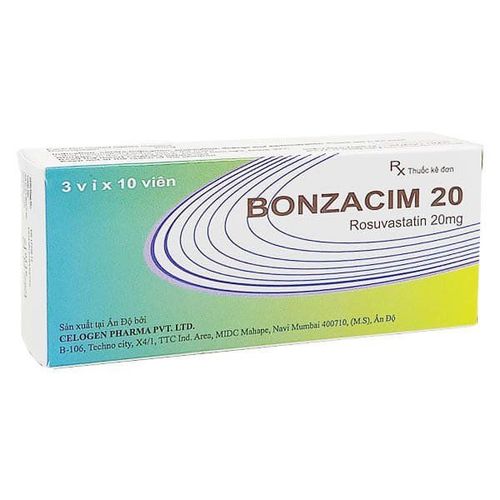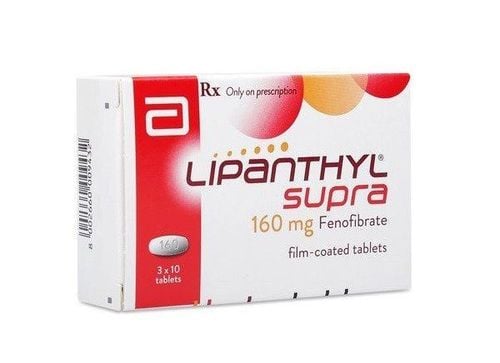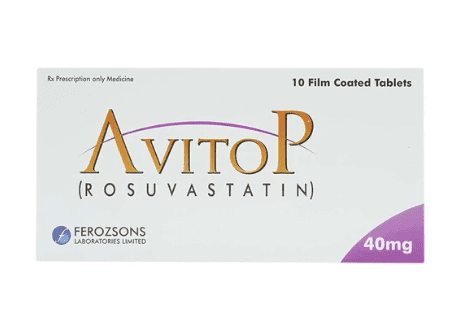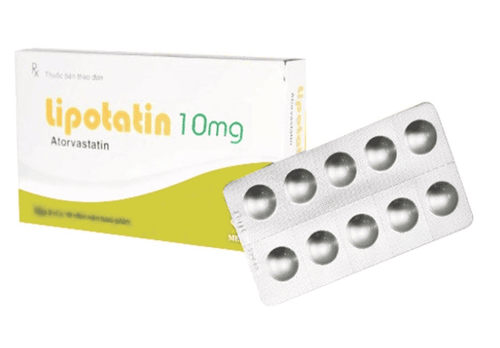This is an automatically translated article.
Storvas drug contains the active ingredient Atorvastatin is indicated in the treatment of hypercholesterolemia, mixed dyslipidemia, hypertriglyceridemia... Let's learn about the uses and notes when using Storvas through the article below. .
1. Uses of Storvas
Storvas medicine contains active ingredient Atorvastatin in tablet form with two strengths: Storvas 10mg and Storvas 20mg. The active ingredient Atovastatin is a competitive inhibitor of HMG - CoA reductase, thereby reducing plasma cholesterol and lipoprotein concentrations, reducing glucose synthesis in the liver by increasing the number of HDL - cholesterol receptors on the cell surface to increase enhanced uptake and catalysis of LDL. Atorvastatin also reduces the production of LDL-cholesterol and the number of LDL-cholesterol particles.
Storvas is indicated in the following cases:
Prevention of cardiovascular disease: Storvas is used in the prevention of cardiovascular diseases including reducing the risk of heart attack, stroke, and reducing the risk of heart disease. revascularization and angina pectoris ; Treatment of hyperlipidemia in adjunct to diet to reduce elevations of total cholesterol, LDL-cholesterol, triglycerides, apo B and increase HDL-cholesterol levels in patients with primary and disordered hypercholesterolemia mixed dyslipidemia;
2. Dosage of Storvas
Storvas drug is used to prevent cardiovascular disease and treat hyperlipidemia with the dose prescribed by the treating doctor based on the patient's condition. Dosage should be determined based on baseline LDL levels, treatment goals, and patient response. Some recommendations on dosage of Storvas are as follows:
Treatment of hyperlipidemia and mixed dyslipidemia: The starting dose is 10-20mg/time/day. Maintenance dose is determined based on patient characteristics as well as treatment goals and patient response. After initiation or titration of Atorvastatin, serum lipid levels should be analyzed within 2–4 weeks and dosage adjusted accordingly; Treatment of heterozygous familial hyperlipidemia in pediatric patients: The recommended initial dose is 10mg/day and the maximum dose should not exceed 20mg/day; Treatment of homozygous familial hypercholesterolemia: The recommended dose is from 10mg to 80mg/day. Storvas should be used as an adjunct to other lipid-lowering treatments; Concomitant lipid-lowering therapy: Storvas may be used concomitantly with a bile acid-binding resin for an additive effect. Avoid combining fibrates with HMG-CoA reductase inhibitors.
3. Undesirable effects of the drug Storvas
Storvas can cause some unwanted effects as follows:
Body as a whole: Fever, fatigue; On the digestive system: Ợ gas, abdominal discomfort, hepatitis, flatulence, biliary obstruction; On the musculoskeletal system: Myalgia, musculoskeletal pain, joint swelling, neck pain; Nutrition and Metabolism: Transaminase elevation, liver function test abnormalities, creatinine phosphokinase elevation, blood alkaline phosphate elevation, hyperglycemia; On the nervous system: Nightmares; On the respiratory system: Nosebleeds; On skin and soft tissues: Urticaria ; Special sensations: Tinnitus, blurred vision; On the genitourinary system: White blood cells in the urine are positive. Patients need to inform their doctor about side effects encountered during treatment with Storvas.
4. Notes when using Storvas
4.1. Contraindications The use of Storvas is contraindicated in the following cases:
People with advanced liver disease, including unexplained persistent elevations in blood transaminases; Patients with hypersensitivity to Atorvastatin or any ingredient of Storvas; Pregnant women or women of childbearing potential who do not use appropriate contraception: There have been reports of adverse effects of Atorvastatin on the fetus and mother. Therefore, the drug is only used for women of reproductive age when these patients are not capable of becoming pregnant and the patient should be informed of the potential harm to the fetus; Lactation: Statins have the potential to cause harm to a nursing infant, so the use of Storvas is contraindicated in lactating women. 4.2. Effects on Skeletal Muscle: Rare cases of rhabdomyolysis have been reported with Atorvastatin with other drugs in this class. Patients with a history of renal failure are a risk factor for the development of rhabdomyolysis. The drug can cause myalgia, myositis, and myopathy that may progress to rhabdomyolysis, a potentially life-threatening condition markedly characterized by elevated serum creatinine kinase levels, myoglobinemia, and myoglobinemia. urine. Therefore, Storvas should be prescribed with caution in patients with rhabdomyolysis, creatinine phosphokinase levels should be measured before treating the following conditions:
Patients with renal failure; Patients with hypothyroidism ; Family history of genetic disorders or individuals with myopathy; Patients with a history of muscle toxicity due to the use of a fibrate or statin; Patients with a history of liver disease or alcohol use; Elderly. During treatment with Storvas, patients should notify their doctor if they develop muscle pain, weakness, cramps or muscle weakness with fever and fatigue.
Liver failure: Atorvastatin, like other Statins, has been associated with biochemical abnormalities of liver function. Persistent elevations in serum transaminases were reported in 0.7% of patients receiving Atorvastatin in clinical trials. It is therefore recommended that liver enzymes be checked before and periodically during treatment with Atorvastatin.
Diabetes: Increased HbAIc levels and increased fasting glucose levels have been reported with HMGCoA reductase inhibitors, including Atorvastatin.
Hormonal function: Statins interfere with cholesterol synthesis and could theoretically decrease adrenal function and/or decrease gonadal steroid production.
Central nervous system toxicity: Animal studies have shown that prolonged use of statins in animals for more than 3 months increases the risk of cerebral hemorrhage. CNS vascular lesions, described as perivascular hemorrhage, and mononuclear cell infiltration in the perivascular spaces, have been reported with statin therapy.
5. Storvas . drug interactions
Storvas may cause the following interactions:
CYP3A4 inhibitors: Atorvastatin is significantly metabolized by cytochrome P450 3A4. Strong inhibitors of CYP3A4 have been shown to significantly increase concentrations of Atorvastatin. Concomitant use of strong inhibitors of CYP3A4 (such as Cyclosporin, Telithromycin, Clarithromycin, Delavirdine, Stiripentol, Ketoconazole, Voriconazole, Itraconazole, Posaconazole and HIV protease inhibitors including Ritonavir, Lopinavir, Atazanavir, Indinavir, darunavir...) dodge if possible. In cases where co-administration of these drugs is required, the dose of Atorvastatin should be initiated lower and the maximum dose of Atorvastatin should be considered and appropriate clinical supervision is observed; Clarithromycin: The AUC of Atorvastatin was significantly increased when Atorvastatin 80 mg was co-administered with clarithromycin (500 mg twice daily) compared with the AUC of Atorvastatin alone. Therefore, in patients receiving clarithromycin, caution should be exercised when the dose of Atorvastatin exceeds 20 mg; Combinations of protease inhibitors: Atorvastatin AUC was significantly increased when Atorvastatin was co-administered with an HIV protease inhibitor, as well as with the hepatitis C protease inhibitor Telaprevir, compared with atorvastatin AUC with atorvastatin alone. poison; Carrier Protein Inhibitors: Drugs that inhibit transport proteins (such as cyclosporin) may increase systemic exposure to Atorvastatin; Cyclosporine: The bioavailability of Cyclosporine is increased with concomitant use of Atorvastatin; Gemfibrozil: Because of the increased risk of myopathy/rhabdomyolysis when HMG-CoA reductase inhibitors are co-administered with Gemfibrozil, avoid concomitant use of Atorvastatin with Gemfñbrozil; Ezetimibe: Increased risk of rhabdomyolysis when used concomitantly with Atorvastatin; Colestipol: Plasma concentrations of Atorvastatin are reduced by approximately 25% when co-administered with Colestipol. Niacin: The risk of effects on skeletal muscle may be enhanced when Atorvastatin is used in combination with Niacin; Oral Contraceptives: Concomitant use of Atorvastatin and an oral contraceptive increases the AUC values of norethindrone and ethinyl estradiol. An increase in these values should be considered when selecting an oral contraceptive for women taking atorvastatin; Digoxin: Concomitant administration of multiple doses of Atorvastatin with Digoxin increases the steady-state concentration of Digoxin by approximately 20%. Therefore, patients receiving Digoxin should be appropriately monitored. The above are the uses of the drug Storvas, if in the process of using the patient have any problems that need advice, they can contact the prescribing doctor for appropriate indications.
Please dial HOTLINE for more information or register for an appointment HERE. Download MyVinmec app to make appointments faster and to manage your bookings easily.













